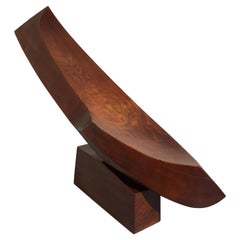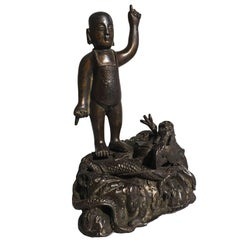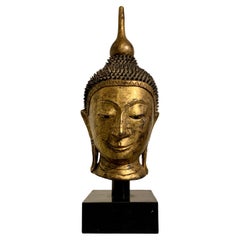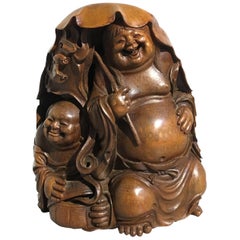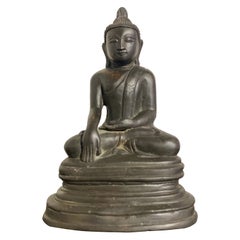Texas - Sculptures and Carvings
to
13
212
2,047
1,474
207
5
5
1
1
1
75
48
84
5
34
22
13
6
3
5
1
1
1
6
1
1
81
65
64
41
39
193
114
80
52
26
212
212
212
1
1
1
1
Item Ships From: Texas
Japanese Abstract Expressionist Carved Wood Sculpture by Takao Kimura
By Takao Kimura
Located in Austin, TX
A powerful abstract expressionist caved elm wood sculpture by Japanese artist Takao Kimura, circa 1970s. Carved in two parts, the swooping, concave body plays dramatically with the o...
Category
1970s Japanese Expressionist Vintage Texas - Sculptures and Carvings
Materials
Elm
Ming Dynasty Bronze Figure of the Infant Buddha
Located in Austin, TX
A rare and unusual Chinese Ming Dynasty bronze figure of the Buddha as an infant. The young Prince Siddhartha, who would grow up to become the Buddha, is portrayed standing, one hand pointing to the sky, the other to the ground. He is naked, save for a baby apron...
Category
16th Century Chinese Ming Antique Texas - Sculptures and Carvings
Materials
Bronze
Japanese Tokyo School Bronze Okimono of a Farmer, Meiji Period
Located in Austin, TX
A very fine and detailed Tokyo School cast bronze okimono (decorative sculpture) of a smiling farmer, Meiji period, late 19th century, Japan.
The e...
Category
Late 19th Century Japanese Meiji Antique Texas - Sculptures and Carvings
Materials
Bronze
Vintage Shan Burmese Style Gilt Dry Lacquer Buddha Head, circa 1960s, Thailand
Located in Austin, TX
A serene vintage Buddha head of gilt dry lacquer in the Shan Burmese style, but made in Thailand for the export market, circa 1960s, mounted on a b...
Category
1960s Thai Vintage Texas - Sculptures and Carvings
Materials
Laminate, Lacquer
Chinese Qing Dynasty Carved Bamboo HeHe ErXian Group, 19th Century
Located in Austin, TX
A wonderful Chinese bamboo figural carving featuring the Taoist immortal twins of eternal youth, known as the HeHe ErXian, Qing dynasty, 19th century.
F...
Category
19th Century Chinese Qing Antique Texas - Sculptures and Carvings
Materials
Bamboo
Burmese Bronze Arakan Style Seated Buddha, Mid 20th Century, Burma
Located in Austin, TX
A delightful Burmese cast bronze Buddha in the Arakan style, mid 20th century, Myanmar (Burma).
The Buddha sits in the full lotus position, the soles of his feet turned up. His ha...
Category
Mid-20th Century Burmese Texas - Sculptures and Carvings
Materials
Bronze
Tang Dynasty Painted Terracotta Sculpture of a Lokapala
By Tang Dynasty
Located in Dallas, TX
Tang Dynasty terracotta Pottery Tomb figure of the Lokapala Warrier Deity. Figure molded wearing heavy armor, standing in a dynamic pose with left arm raised in a threatening gesture...
Category
15th Century and Earlier Chinese Tang Antique Texas - Sculptures and Carvings
Materials
Terracotta
Indonesian Majapahit Terracotta Head of a Male, circa 14th Century
Located in Austin, TX
A charming head of a young male, Majapahit Empire, region of Trowulan, Eastern Java, Indonesia, 13th-14th century.
The head well sculpted as a smiling, youthful male with buck teet...
Category
15th Century and Earlier Javanese Tribal Antique Texas - Sculptures and Carvings
Materials
Terracotta
Large Over Life-Sized Vintage Thai Bronze Buddha Head, circa 1970's
Located in Austin, TX
An large and impressive vintage Thai cast bronze Buddha head, U-Thong style, 1970's, Thailand.
The larger than life-sized head beautifully c...
Category
1970s Thai Vintage Texas - Sculptures and Carvings
Materials
Bronze
Nepalese Gilt Bronze Bodhisattva 'Amoghapasha?', Early to Mid-20th Century
Located in Austin, TX
A beautiful and unusual gilt bronze figure of a Bodhisattva, possibly Amoghapasha, Nepal, early to mid-20th century, circa 1930s or 1940s.
The regal figure possibly depicting the bodhisattva Amoghapasha, the Unfailing Lasso. The enlightened being is portrayed seated upon a high double lotus pedestal. He is dressed as an Indian prince, wearing a luxurious foliate patterned dhoti around his waist and a billowing scarf around his shoulders. . His torso bare save for the jeweled necklaces and the sacred thread. A five pointed crown with an image of Amitabha Buddha in the central point graces his head.
His princely face cold painted with beautiful detail, his hair colored blue with crushed lapis lazuli, indicating his peaceful nature. Amoghapasha holds a lasso in one hand, an axe in the other. He is considered an emanation of Avalokiteshvara. A bodhisattva of compassion, Amoghapasha is so named because of the lasso he holds in his hand. The lasso represents his vast compassion which is thought to extend to encompass all beings, bringing them into a state of perfection and enlightenment.
The copper base plate, seemingly a later replacement, has been inscribed with a visvajra (double vajra...
Category
Mid-20th Century Nepalese Tibetan Texas - Sculptures and Carvings
Materials
Lapis Lazuli, Bronze
Nepalese Gilt Bronze Figure of Bodhisattva Chenrezig, Mid-20th Century
Located in Austin, TX
A nice vintage early to mid-20th century gilt bronze sculpture of the Buddhist deity Avalokiteshvara in his four armed form, known as Chaturbuhja, or Chenrezig in Tibet.
Chenrezig, a form of Avalokiteshvara, the bodhisattva of compassion (known as Guan Yin or Kwan Yin in Chinese), sits in vajrasana upon a high double lotus pedestal. One pair of hands is clasped in prayer at heart level, the other pair of hands raised upwards at shoulder lever and holding discreet attributes, a mala (prayer beads) in one hand, a lotus blossom in the other.
Chenrezig is dressed in an elaborately patterned floral dhoti that covers his lower half. His torso bare, shoulders covered with a shawl and scarves that billow out around him. He is festooned with jewels, necklaces, bracelets, armlets, earrings, belt and a five pointed crown. The earrings studded with coral. The crown studded with turquoise. His face is cold painted with beautiful details. The hair has been pigmented blue with crushed lapis, indicating his peaceful nature.
The copper base plate is inscribed with a visvajra (double vajra...
Category
Late 20th Century Nepalese Tibetan Texas - Sculptures and Carvings
Materials
Coral, Lapis Lazuli, Bronze
Nepalese Gilt Bronze Buddhist Figure of Manjushri, Early to Mid-20th Century
Located in Austin, TX
A lovely Nepalese gilt bronze figure of Manjushri, the Bodhisattva of Wisdom, early to mid 20th century.
The Bodhisattva of Transcendent Wisdom ...
Category
Mid-20th Century Nepalese Tibetan Texas - Sculptures and Carvings
Materials
Lapis Lazuli, Bronze
Shan Burmese Lacquered and Gilt Wood Buddha, Ava Period, 18th Century
Located in Austin, TX
A rare and exquisite 18th century Ava period Shan Burmese figure of the Buddha.
Carved from a single block of wood, lacquered and gilt, the immensely s...
Category
Mid-18th Century Burmese Antique Texas - Sculptures and Carvings
Materials
Teak
Lao Cast Bronze Shakyamuni Buddha, 17th-18th Century
Located in Austin, TX
A beautiful figure of the historical Buddha Shakyamuni seated in bhumisparsha, signifying the moment of the Buddha's enlightenment, Laos, 17th-18th century.
Well cast and displaying a beautiful patina, the Buddha sits upon a separately cast high pedestal, legs folded in vajrasana, one hand held in his lap, the other draped gracefully over his knee, long fingers reaching down to touch the earth, calling it to witness his enlightenment.
The Buddha's heart-shaped face is simply divine, with high, arched brows over downcast eyes, a broad nose, and full lips pursed...
Category
Early 1700s Laotian Antique Texas - Sculptures and Carvings
Materials
Bronze
Burmese Shan Ava Style Cast Bronze Buddha, 19th/20th Century, Burma
Located in Austin, TX
A delightful Shan Burmese cast bronze seated Buddha in the Ava style, late 19th or early 20th century, Burma.
The Buddha sits upon a high, well cast double lotus pedestal. He is s...
Category
Early 20th Century Burmese Texas - Sculptures and Carvings
Materials
Bronze
Burmese Ava Period Carved, Lacquered and Giltwood Buddha, Late 18th Century
Located in Austin, TX
A sublime and rare late 18th century Burmese Ava period carved, lacquered and gilt Buddha. The historical Buddha, Shakyamuni, is portrayed in bhumisparsha mudra, the gesture of calling the Earth to witness, commemorating the moment the Buddha reached enlightenment.
The Buddha is dressed in patchwork...
Category
Late 18th Century Burmese Antique Texas - Sculptures and Carvings
Materials
Wood
A Japanese Bronze Monkey Smoking A Pipe
Located in Dallas, TX
A Japanese bronze monkey smoking a pipe. Early 20th century
Category
Early 20th Century Japanese Edo Texas - Sculptures and Carvings
Materials
Bronze
Very Elegant Tang Dynasty Dignitary in Orange Terracotta, China '618-907 AD'
Located in San Pedro Garza Garcia, Nuevo Leon
Very elegant terracotta dignitary in blue and red robes standing with the hands joined at the chest. He wears a blue headdress with a bird at its center. Orange Terracotta
This gorg...
Category
15th Century and Earlier Chinese Tang Antique Texas - Sculptures and Carvings
Materials
Terracotta
Set of 3 Masatoyo "Kuki" Kishi Penguin Sculptures
By Masatoyo Kishi
Located in Dallas, TX
Set of 3 Mid-Century Modern cast stone penguin sculptures by noted Japanese abstract artist Masatoya "Kuki" Kishi (1924-2017). Signed and numered 4/100. ...
Category
1970s Organic Modern Vintage Texas - Sculptures and Carvings
Materials
Cast Stone
$4,640 Sale Price / set
20% Off
Winged Griffin Façade Ornament
Located in Round Top, TX
Decorative cast iron winged griffin façade ornament from Chicago's Michigan Ave.
Category
1930s American Vintage Texas - Sculptures and Carvings
Materials
Iron
Marlene Rose (b. 1967) Head of Buddha, 2004 Sand Cast Glass and Steel Sculpture
Located in Austin, TX
Marlene Rose, an internationally acclaimed award-winning sculptor, masterfully creates stunningly beautiful works of art in her chosen medium: sand-cast glass. Her sculptures resonate with references and allusions to ancient cultures and civilizations, blending the timeless with the contemporary.
The Buddha’s head sculpture is a mesmerizing fusion of form and material. Hand-cast from molten glass, it captures the serene countenance of the enlightened one. The translucent green glass seems to glow from within, evoking a sense of inner peace and spiritual depth.
As you gaze upon this exquisite piece, you’ll notice the intricate details—the delicate curves of the Buddha’s features, the serene, closed eyes, and the subtle lines that hint at wisdom and compassion. The play of light and shadow on the glass surface adds an ethereal quality, inviting contemplation and reflection.
Marlene Rose’s work has found its place in museums and galleries across the United States and Europe. Collectors, glass enthusiasts, and even Hollywood A-list celebrities seek out her sculptures. Each piece she creates is a testament to her mastery of the sand-cast glass technique and her ability to infuse it with profound meaning.
Whether displayed in a gallery or a private collection, the Buddha’s Head sculpture by Marlene Rose invites viewers to connect with the timeless wisdom and tranquility it embodies.
Provenance: Adamar Fine Arts...
Category
21st Century and Contemporary Texas - Sculptures and Carvings
Materials
Steel
Vintage Burmese Polychrome Animated Mounted Puppet Heads w/ Expressive Features
Located in Austin, TX
This captivating set of two polychrome puppet heads, meticulously mounted, transports viewers to the vibrant world of Burmese artistry. Handcrafted, these expressive puppet heads com...
Category
20th Century Texas - Sculptures and Carvings
Materials
Iron
$320 Sale Price / set
36% Off
Tang Dynasty Court Official in Sancai Glazed Robes, China '618-907' - TL Tested
Located in San Pedro Garza Garcia, Nuevo Leon
A Tang dynasty sancai (three color) glazed pottery model of a Taoist official, TL tested by Ralf Kotalla - worldwide oldest private laboratory specialized for genuine thermoluminesce...
Category
15th Century and Earlier Chinese Tang Antique Texas - Sculptures and Carvings
Materials
Terracotta
Buddhist Stele in Marble from Hebei Province, China w/Custom Stand
Located in Austin, TX
This exquisite stele, hewn from pristine marble, beckons visitors with its ethereal presence. The scene was originally commissioned in 537 by Yuan’ning, prince of the Gaoping branch ...
Category
20th Century Chinese Qing Texas - Sculptures and Carvings
Materials
Marble
$15,000 Sale Price
40% Off
Monumental Buddha Torso White Marble Sculpture - Tang Dynasty China 618-907 AD
Located in San Pedro Garza Garcia, Nuevo Leon
Beautiful and impressive early Tang white marble sculpture of headless Buddha, dressed in an elegant pleated toga. China. 618-907 AD. A true collectors piece.
This magnificent piece...
Category
15th Century and Earlier Chinese Tang Antique Texas - Sculptures and Carvings
Materials
Marble
Sculpture / Phrygian Helmet on a Halberd with Crossed Horns
Located in Dallas, TX
a French sculpture, paint and parcel gilt metal, of a Phrygian helmet (with gilt details) including gilt feather trim, on a halberd, with crossed horn and a gold trumpet, a gilt ribb...
Category
19th Century English Antique Texas - Sculptures and Carvings
Materials
Iron
Blanc de Chine Porcelain Buddha Figure
Located in Dallas, TX
A Dehua figure of Buddha, Qing dynasty, early 18th century.
Category
Early 18th Century Chinese Qing Antique Texas - Sculptures and Carvings
Materials
Porcelain
Wood Carving Sculpture
Located in Dallas, TX
This wood carving sculpture origins from China, circa 1880.
Category
19th Century Chinese Antique Texas - Sculptures and Carvings
Materials
Wood
Marlene Rose (b. 1967) Head of Buddha, 2004 Sand Cast Glass and Steel Sculpture
Located in Austin, TX
Marlene Rose’s “Buddha’s Head” is a harmonious fusion of ancient wisdom and contemporary craftsmanship. The artist’s mastery lies in her ability to distill profound spirituality into tangible form.
The sculpture portrays Buddha’s visage—a timeless symbol of enlightenment and compassion. The closed eyes evoke meditation, inviting viewers to explore their own inner landscapes. The serene expression transcends time, whispering secrets of inner tranquility.
The sand cast technique lends an organic texture to the sculpture. Each grain seems to hold whispers of ancient mantras, echoing across centuries. The pinkish hue, reminiscent of dawn’s first light, bathes the head in a gentle glow.
The ushnisha—the cranial bump atop Buddha’s head—symbolizes heightened consciousness. It’s as if the artist captured a moment of enlightenment frozen in time. The tight curls framing the face signify wisdom gained through introspection.
Mounted on a sleek cylindrical stand, the sculpture defies gravity. Its weightlessness mirrors the spiritual ascent—a journey from the mundane to the sublime. The dark background accentuates the head’s ethereal presence.
“Buddha’s Head” beckons viewers to seek solace within themselves. It whispers, “Find your inner temple, where silence blooms like lotus petals.”
Marlene Rose’s creation transcends mere art...
Category
21st Century and Contemporary Texas - Sculptures and Carvings
Materials
Steel
Eternal Blossoms: A Chinese Soapstone Masterpiece
Located in Austin, TX
This exquisite large Chinese soapstone sculpture is a testament to the intricate artistry and rich cultural heritage of China. The piece, meticulously carved from a single block of v...
Category
Early 20th Century Chinese Texas - Sculptures and Carvings
Materials
Soapstone
$7,350 Sale Price
30% Off
Eastern Han Dynasty Terracotta Model of a Paper Mill , China '206BC - 220AD'
Located in San Pedro Garza Garcia, Nuevo Leon
Slab pottery constructed Model of a Paper Mill, in Green and Cream Color Glazed Terracotta having a peaked roof – open walled form with a mechanical pounder and a large round storage container. Light blue-green mottled glazed surface with some iridescence patina to the glaze. The Iridescence is a refraction of the layers on the glass that produces multicolor hues & metallic luster, and only develops after one thousand years of being buried in the ground. An unquestionable mark of antiquity, impossible to falsify.
Han Dynasty, dated 206 B.C-220 A.D.
Condition: Excellent, wear commensurate with age, an unusual example.
This fantastic piece is accompanied by a Certificate of Authenticity.
Sculptural effigies of domesticated animals were often interred in the tombs of nobility and elite members of the social hierarchy. Models like this one were made to represent everything from simple goat or pig pens to the most elaborate towers and palaces. Because very few ancient Chinese buildings have survived intact, these models, along with descriptions from ancient texts, give a good representation of what the buildings might have looked like.
Burial figurines of graceful dancers, mystical beasts, and everyday objects reveal both how people in early China approached death and how they lived. Since people viewed the afterlife as an extension of worldly life, these figurines, called mingqi, sometimes referred as “spirit utensils” or “vessels of ghosts” disclose details of routine existence and provide insights into belief systems over a thousand-year period. For the first time in Chinese history, we have images of rural and daily life during the Han in the form of contemporary records...
Category
15th Century and Earlier Chinese Han Antique Texas - Sculptures and Carvings
Materials
Terracotta
Eastern Han Dynasty Terracotta Barn Workshop, China '206BC - 220AD' Ex-Museum
Located in San Pedro Garza Garcia, Nuevo Leon
Slab pottery constructed barn workshop having a peaked roof – open walled form with a mechanical pounder and a large round covered storage container. Light blue-green mottled glazed surface with some iridescence patina to the glaze.
Condition: Intact, excellent condition, an unusual example.
Provenance: The Living Torah Museum, Brooklyn; ex. Sands of Time, 2002.
Sculptural effigies of domesticated animals were often interred in the tombs of nobility and elite members of the social hierarchy. Models like this one were made to represent everything from simple goat or pig pens to the most elaborate towers and palaces. Because very few ancient Chinese buildings have survived intact, these models, along with descriptions from ancient texts, give a good representation of what the buildings might have looked like.
This fantastic piece is accompanied by a Certificate of Authenticity.
Burial figurines of graceful dancers, mystical beasts, and everyday objects reveal both how people in early China approached death and how they lived. Since people viewed the afterlife as an extension of worldly life, these figurines, called mingqi, sometimes referred as “spirit utensils” or “vessels of ghosts” disclose details of routine existence and provide insights into belief systems over a thousand-year period. For the first time in Chinese history, we have images of rural and daily life during the Han in the form of contemporary...
Category
15th Century and Earlier Chinese Han Antique Texas - Sculptures and Carvings
Materials
Terracotta
Read More
12 Calming Spaces Inspired by Japanese Design
From cherry-blossom-adorned walls paired with glamorous lighting to wood-paneled ceilings above checkerboard-patterned chairs, these 12 spaces seamlessly blend Eastern and Western aesthetics.
Rodrigo Rivero Lake’s Mexico City Showroom Is a Museum-Worthy Trove of Spanish Colonial and Asian Antiques
The dealer and curator has spent the past 50 years amassing a collection of exceptional art, furniture and architectural elements that trace the cultural influence of the Spanish empire from Europe to the Americas and beyond.
Recently Viewed
View AllMore Ways To Browse
Garden Rabbit Sculpture
Japanese Daruma
Rice Pounder
Indonesian Stone Carving
Japan Bronze Buddha Statue
Japanese Kimono Doll
Japanese Root Carving
Nat Statue
Japanese Carved Dog
Japanese Ivory Carvings
Japanese Toad
Japanese Wood Okimono
Ningyo Dolls
Indian Stone Head
Jade Bi Disc
Japanese Rabbit Sculpture
Jizo Bosatsu
Meiji Bronze Samurai
